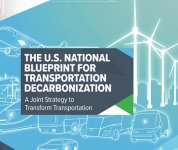TDRComm
Staff Member

SANITY IN GOVERNMENT—AN OXYMORON?
The title needs no further explanation.
However, when you do see a report on “sanity in government” you should sit-up and take notice.
Attention in the classroom: Here are excerpts from an online posting at the Diesel Technology Forum, from executive director Allen Schaffer, that gives us a look into a governmental report on the future make-up of the transportation industry in the US. Schaffer does an excellent job of summarizing the 88-page report which was a collaboration of the Department of Energy; Transportation; Housing and Urban Development; and the EPA. The entire document (excuse me, “Memorandum of Understanding” or MOU) was released on January 17. Here are excerpts from Schaffer’s summary. (Wow, 88 pages down to four paragraphs.)
“If you’re doubting the future for internal combustion engines and sustainable liquid fuels, look no further than the Biden Administration’s National Blueprint for Transportation Decarbonization: A Joint Strategy to Transform Transportation. The Blueprint is a “whole-of-government approach” to addressing the climate crisis and meeting President Biden’s goals of a 100% clean electrical grid by 2035 and net-zero carbon emissions by 2050.
“So much emphasis is placed on electrification that the other important options for decarbonization often get left behind, namely hydrogen and sustainable liquid fuels.
“Sustainable fuels have quite a considerable role to play in this vision of our transportation future. They’re expected to be as significant as battery electric in some sectors. The Blueprint shows hydrogen having a large role to play for long-haul trucking, but also notes that ‘sustainable liquid fuels may also be an option for some Medium and Heavy-Duty Vehicles (MHDVs), particularly for remote applications and for legacy vehicles relying on internal combustion engines. (TDR members, make note of this new ‘category’ for our trucks. We are now MHDV owners.) The historically slow turnover rate for many MHDVs means that new technologies may not replace diesel engines for several decades and that disseminating new technology across the MHDV fleet will be a slow process if market forces or policy decisions do not accelerate vehicle turnover. Sustainable fuels could help alleviate this turnover challenge by providing low-carbon solutions that are compatible with existing vehicles.’”
Schaffer continues, “When you think about it, it’s a logical approach to think broadly about transport and mobility, where we work and live, as well as the energy and environmental impacts of our transportation decisions. The Administration sees it as a ‘significant milestone on the path to realizing an improved and sustainable transportation future.’ The 88-page ‘Blueprint’ is definitely a strong start.”
Finally, Schaffer adds a bit of context to the situation, “But if you’ve been part of any construction or remodeling projects, you know that there are original blueprints and then there are ‘as-built’ blueprints. Those reflect the realities of changing conditions and preferences along the way. And that’s exactly how we should think of this National Blueprint for Transportation Decarbonization; one written in pencil and not in stone.”
MHDV owners, perhaps our future is in a “sustainable liquid fuel” and we can label the fuel with a name that sounds eco-friendly. There it is, a solution to the diesels bad image problem!

 Attention: TDR Forum Junkies
Attention: TDR Forum Junkies 






